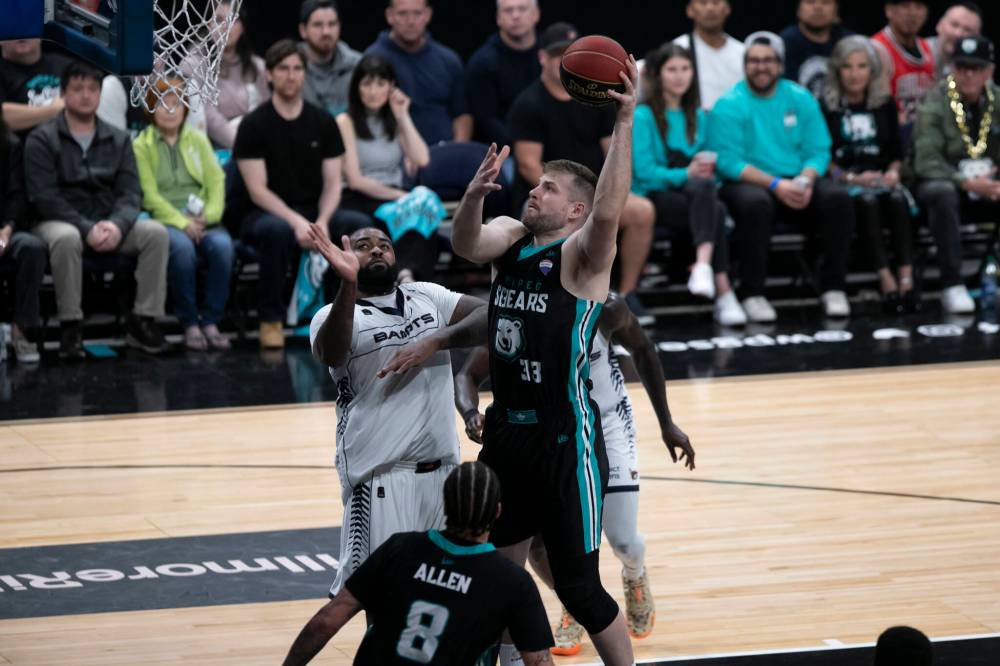Elam Ending 101: explaining unique finish to CEBL games
Read this article for free:
or
Already have an account? Log in here »
To continue reading, please subscribe:
Monthly Digital Subscription
$19 $0 for the first 4 weeks*
- Enjoy unlimited reading on winnipegfreepress.com
- Read the E-Edition, our digital replica newspaper
- Access News Break, our award-winning app
- Play interactive puzzles
*No charge for 4 weeks then billed as $19 every four weeks (new subscribers and qualified returning subscribers only). Cancel anytime.
Read unlimited articles for free today:
or
Already have an account? Log in here »
Hey there, time traveller!
This article was published 31/05/2023 (323 days ago), so information in it may no longer be current.
Nick Elam was a high school math teacher in 2007 when he got an idea that is helping to spark a mini-revolution in basketball.
The so-called Elam Ending, a rule now in regular use by the Canadian Elite Basketball League, is a customized ending to a game that forces players and coaches to avoid the spectacle of constant fouling that often turns into a tedious late-game routine.
The Elam Ending, or Target Score system as the CEBL now refers to it, was used to spectacular effect when the Winnipeg Sea Bears beat the Vancouver Bandits 90-85 in their franchise debut last Saturday.
Winnipeg Sea Bears forward Chad Posthumus (Brook Jones / Winnipeg Free Press files)
Winnipeg held a 13-point lead (80-67) with 3:48 left in the game. But under the CEBL’s unique Elam Ending rule, the clock is turned off following the first play stoppage in the final four minutes and the game ends when either team reaches the target score — equal to the leading team’s point total plus nine. The target score was set at 89.
Local fans, likely baffled by the format when the game began, were quickly sucked into the tension-filled drama.
The big Winnipeg lead evaporated during an 18-5 run by the Bandits and the teams were tied 85-85 before a breathless final sequence began. Jelani Watson-Gayle hit a clutch three-pointer and Chad Posthumus’ put-back basket gave Winnipeg its inaugural victory.
Fans and players were buzzing afterward.
‘A pretty simple idea’
“When you hear about the idea for the first time, it really sounds like an idea from outer space, but then you see it in action and you realize, ‘Oh, this is actually a pretty simple idea,’ ” said the 40-year-old Elam, reached by phone earlier this week in Muncie, Ind., where he is an assistant professor at Ball State University.
“I think it’s more illuminating in practice than it is through any sort of written or verbal explanation of it.”

The proof of Elam’s acceptance is growing. Sixteen years after he first came up with a framework for the rule, the Elam Ending has been used in some form during ESPN’s That Basketball Tournament, the last four seasons at the NBA all-star game, NBA’s G League and, since 2020, in the CEBL.
“It was just baffling to me that in a basketball game it’s so common to reach a stage where the trailing team’s only recourse was to overtly violate the rules of the sport,” said Elam, whose ultimate goal is to see the NBA adopt Elam Endings for regular-season games.
“Their only way to try to win the game was to break the rules by fouling, and to me that that in itself was enough of a fundamental flaw…
“What made it even worse is that deliberate fouling in basketball is a flaw but it is not even a cool flaw. It takes a game that’s competitive and fluid and athletic and suspenseful and just brings it to a screeching halt and doesn’t change the outcome of the game. It just takes all the air out of the arena.
“What I found later, through my research, was really eye-opening to me: When a team resorts to that deliberate fouling strategy they only come back to win the game about one per cent of the time and yet under a timed format, it was still their best option.”
‘Coaches hate it’
Traditionalists may not like it, but the Elam Ending has become a permanent fixture in the CEBL.
“Coaches hate it,” said Bandits head coach Kyle Julius after Saturday’s game. “But you know what? In all honesty, we’re not back in that game if it isn’t for Elam, right? Just the way that it makes people rush and play.
“I thought we did a tremendous job of executing in Elam getting the shots we wanted, with the pace that we wanted. It took us a while to kind of understand a few things defensively.”
Sea Bears GM and head coach Mike Taylor seemed more eager to embrace the Target Score system.
“I think it’s exciting and especially when your team hits a game-winning shot like Chad’s put-back, it’s unbelievable,” said Taylor.
“But also I think coaches have to accept that they don’t have as much control over the execution and over the play… You’ve got to use your time in practice to prepare for it or else you’re going to be really inefficient in the Elam Ending.”
To simulate game conditions, the Sea Bears will play short three- or four-minute scrimmages and add nine points to help players get accustomed to the rhythm of Target Score basketball.
“It looks like it’s really just straight-out simple, but there’s lots of angles,” added Taylor. “It’s situational. Are you in the lead? Are you trailing? What’s the deficit? How are you best to trigger it? Do you have fouls to give?
“And then what’s really interesting to me is I feel like it’s a player’s game. You have to have the players prepared to execute in a certain way.
“There’s a lot of human nature that gets involved, where players try to hit that game-winning shot or try to make the game-winning play. Sometimes better to be a little bit more conservative and focus on other things rather than making that big shot.”
More authentic, assertive play
The impact is just what CEBL commissioner Mike Morreale was hoping for when he first approached Elam for his analytics-based approach in the summer of 2019.
“It really becomes backyard basketball and next bucket wins,” said Morreale. “The game gets more physical. The referees understand the importance of letting the players play, so that we don’t get into situations where you’re ending games on a free-throw situation.
“We want there to be a game-winning bucket.”
“We want there to be a game-winning bucket.”–Mike Morreale
Following every season, Elam prepares a report analysing the impact of the rule in the CEBL and if tweaks are required.
“The really cool part about the format is that it’s not meant to change the sport of basketball,” said Elam. “It is meant to do the opposite of changing basketball. It’s meant to return it to a more authentic and assertive and familiar style of play.
“I think some people when they first hear about the idea they call it a gimmick. I say it’s an anti-gimmick, because I believe that the style of play, the quality of play that you see as an Elam Ending during the late stages of the game looks more like real basketball than what we’re used to seeing when we’re in a timed format.”
mike.sawatzky@freepress.mb.ca
Twitter: @sawa14

Mike Sawatzky
Reporter
Mike has been working on the Free Press sports desk since 2003.




